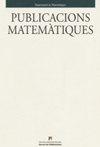莱维特路径代数中的不变理想
IF 1
3区 数学
Q2 MATHEMATICS
引用次数: 0
摘要
已知由p1 (E)、p1 (E)、p3 (E)生成的莱维特路径代数lk (E)的理想在同构条件下是不变的。虽然由P∞(E)生成的理想不是不变的,但我们找到了它的“自然”替代(它确实是不变的):由P∞P的顶点(具有纯无限分岔的顶点)生成的理想。并给出了由已知的不变理想构造不变理想的过程。其中一个过程涉及到拓扑,因此我们引入DCC拓扑,并将其与代数对应的工作中的湮灭子联系起来。更明确地说:如果H是提供不变理想的顶点的遗传饱和子集,那么它在e0的DCC拓扑中的外部(H)产生一个新的不变理想。不变理想的另一个构造者在本质上是更明确的。一些遗传集合可以看作是从图到集合的函子(例如p1等)。因此,从将诱导函子应用于商图的可能性中产生了第二种方法。最简单的例子是已知的社会链Soc(1)()、Soc(2)()等,均被证明是不变量。我们将这个思想推广到任何遗传和饱和不变函子。最后,我们研究了一类结合的遗传和饱和函子的组合。本文章由计算机程序翻译,如有差异,请以英文原文为准。
Invariant ideals in Leavitt path algebras
: It is known that the ideals of a Leavitt path algebra L K ( E ) generated by P l ( E ), by P c ( E ), or by P ec ( E ) are invariant under isomorphism. Though the ideal generated by P b ∞ ( E ) is not invariant we find its “natural” replacement (which is indeed invariant): the one generated by the vertices of P b ∞ p (vertices with pure in-finite bifurcations). We also give some procedures to construct invariant ideals from previous known invariant ideals. One of these procedures involves topology, so we introduce the DCC topology and relate it to annihilators in the algebraic counterpart of the work. To be more explicit: if H is a hereditary saturated subset of vertices providing an invariant ideal, its exterior ext( H ) in the DCC topology of E 0 generates a new invariant ideal. The other constructor of invariant ideals is more categorical in nature. Some hereditary sets can be seen as functors from graphs to sets (for instance P l , etc.). Thus a second method emerges from the possibility of applying the induced functor to the quotient graph. The easiest example is the known socle chain Soc (1) ( ) ⊆ Soc (2) ( ) ⊆ ··· , all of which are proved to be invariant. We generalize this idea to any hereditary and saturated invariant functor. Finally we investigate a kind of composition of hereditary and saturated functors which is associative.
求助全文
通过发布文献求助,成功后即可免费获取论文全文。
去求助
来源期刊
CiteScore
1.60
自引率
0.00%
发文量
29
审稿时长
>12 weeks
期刊介绍:
Publicacions Matemàtiques is a research mathematical journal published by the Department of Mathematics of the Universitat Autònoma de Barcelona since 1976 (before 1988 named Publicacions de la Secció de Matemàtiques, ISSN: 0210-2978 print, 2014-4369 online). Two issues, constituting a single volume, are published each year. The journal has a large circulation being received by more than two hundred libraries all over the world. It is indexed by Mathematical Reviews, Zentralblatt Math., Science Citation Index, SciSearch®, ISI Alerting Services, COMPUMATH Citation Index®, and it participates in the Euclid Project and JSTOR. Free access is provided to all published papers through the web page.
Publicacions Matemàtiques is a non-profit university journal which gives special attention to the authors during the whole editorial process. In 2019, the average time between the reception of a paper and its publication was twenty-two months, and the average time between the acceptance of a paper and its publication was fifteen months. The journal keeps on receiving a large number of submissions, so the authors should be warned that currently only articles with excellent reports can be accepted.

 求助内容:
求助内容: 应助结果提醒方式:
应助结果提醒方式:


